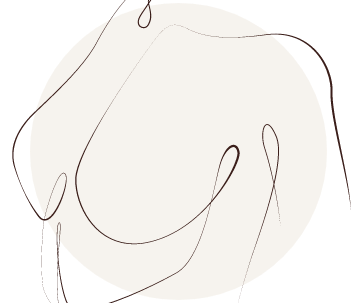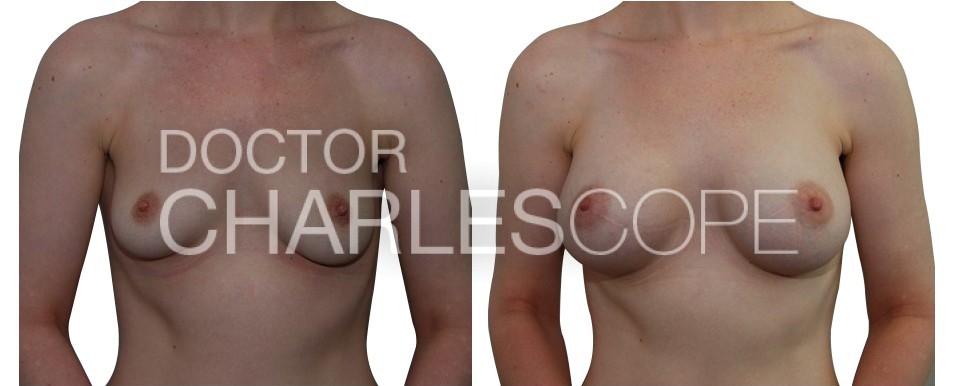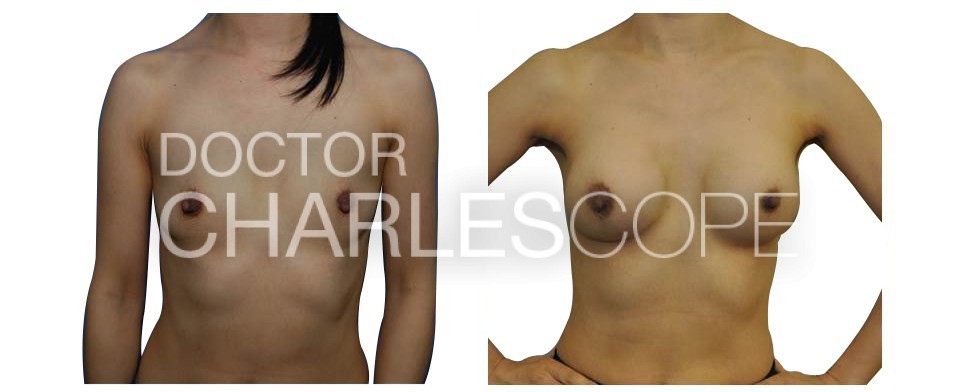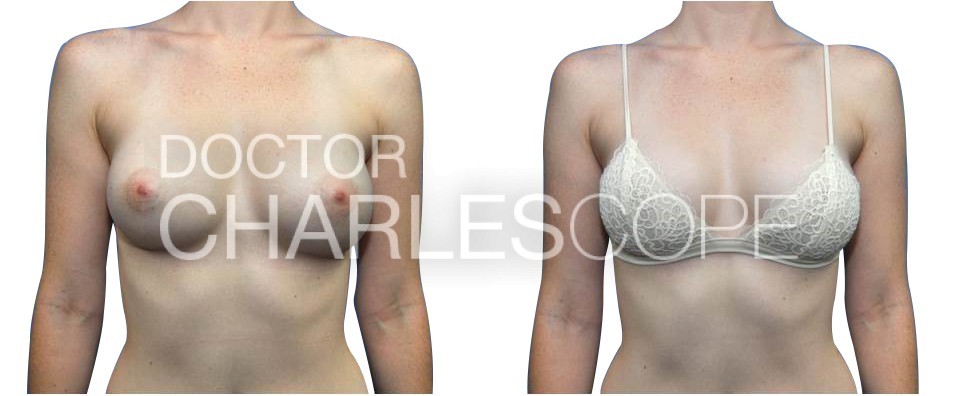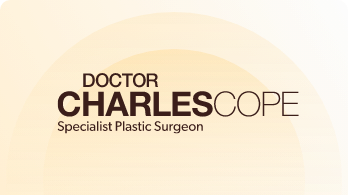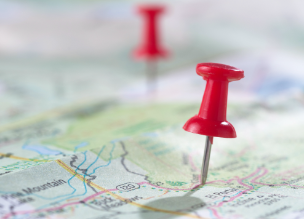Breast augmentation or breast enlargement enlarges your breasts and makes them more proportional with the rest of your body. Implants can also be used to correct a small amount of breast ptosis or loose skin which can occur after pregnancy and breast-feeding. If there is a large amount of loose skin then breast implants combined with a breast lift (mastopexy) is necessary.
There are many choices and options, which require careful planning to work out which is the best option for you. All of these choices have advantages and disadvantages, which you should understand before you make the decision.
7 out of 8 women have minor differences between their breasts, which is normal. It is important to understand that minor differences in the size and shape of your breasts will not change and may even be more obvious after breast augmentation surgery.
Minor volume differences can be improved by using fat transfer to the breast, or if there is a large volume difference between your breasts, breast implants are one of the options that can be used to improve volume differences between your breasts if this is bothering you.
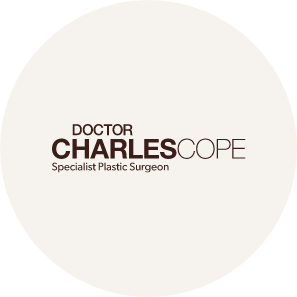
Dr Charles Cope is one of only a few surgeons offering breast augmentation in Sydney to have the VECTRA XT 3D imaging system, which is the latest 3D technology that allows you to see the simulated result of your breast augmentation surgery during your consultation.
The VECTRA takes a 3D image of your breasts then allows you to see simulations of what your breasts would look like with different size implants, helping you to make a more informed decision about your implant size.
In an article (Oct 2013) of Plastic & Reconstructive Surgery Journal (Plast. Reconstr. Surg. 132: 810, 2013.), the main Plastic Surgery Journal worldwide, the 3D imaging VECTRA machine was found to be beneficial for patients considering breast augmentation surgery. The article concluded that patients prefer a center that offers three-dimensional imaging technology; they feel that the simulation is very accurate and helps them greatly in choosing the implant; and that if they could go back in time, they would choose the same implant again. See some examples of how reliable the Vectra can be for predicting the postoperative results of breast augmentation here.*
*Note results vary from patient to patient
choices and options for Breast augmentation with implants (breast enlargement)
There are two options for the placement of breast implants: they are placed either behind the breast tissue or under the muscle on the chest wall (pectoralis muscle). Breast implants placed underneath the muscle have a more natural shape, a lower chance of capsular contracture (hardening), and it is easier for mammography. However, if you do a lot of upper limb gym work then implants are best placed under the breast. The implant can be slid into place three ways; through an incision under the areola, in the crease under the breast or via the armpit.
Most patients choose silicone breast implants rather than saline breast implants, which can be associated with rippling that can be seen through the skin. Modern silicone implants are substantially different from the old type of silicone implants used in the 1970s and 80s. The casing of the implant is much thicker and usually has a textured surface, which reduces the chance of hardening of the implant. Cohesive Silicone Gel implants contain a gel that is similar in consistency to a set jelly, which retains its shape and does not run like a liquid, as the old silicone gel did. Another advantage of the Cohesive Gel implants is that they can be made breast shaped, helping to give a more natural result.
Breast augmentation surgery requires a general anaesthetic, with the operation taking about one hour, and is usually performed as a day-stay or overnight-stay procedure. Following the surgery it is important to have restricted light activities, with no lifting or heavy duties for 7-10 days. Most patients may drive again and return to work within 10 days after the surgery*. Heavy activities and sport should not be undertaken for at least one month following breast enlargement surgery*.
*Note results vary from patient to patient
Frequently Asked Questions
Breast augmentation will enlarge your breasts, making them more in proportion to the rest of your body. If you have loose skin or mildly ptotic (droopy) breasts, which commonly often occur after pregnancy, breast feeding and weight loss, breast implants can be used to correct these problems. Breast implants are also one of the options to improve volume differences between your breasts if you have a large size difference and this is bothering you.
Several factors can affect the total costs of your breast augmentation surgery. These include the following:
Surgeon’s fees
This usually includes the cost of postoperative care. The fees of your surgeon will depend on their professional qualifications and experience.
Anaesthetist’s fees
This will also depend on the experience and expertise of the anaesthetist. Depending on the anaesthetist, they may charge by the hour or procedure.
Initial consultation fees
You’ll need to pay $380 when you first consult with your surgeon regarding the procedure (price at July 2021).
Cost of breast implants
This will depend on the type of implant that will best suit your body type and desired results. The cost of breast implants also depends on their brand. Typical costs vary between $1700 and $2500 for both implants.
Hospital fees
You may need to pay more if you need to stay overnight (usually about $350 to $400 extra). Depending on your condition, you may be able to go home the day of your surgery.
Other costs
This includes medical tests, supportive garments, and other materials used during your surgery.
During your consultation with Dr Cope, we will discuss all of the factors that may affect the total costs of your surgery. The total price of a breast augmentation (including surgeon, anaesthetist, implants, and hospital fees) starts at around $13,300, but can go up to $15,000 or more, depending on type of implant used and the complexity of your procedure. After the consultation we will provide you with an accurate estimate of the costs involved.
Breast augmentation can be performed at any age once your breasts have stopped developing (often about 16-18 years of age). If you are about to have children soon then you should wait until after pregnancy and breast feeding, as these often change your breasts and change the result of breast augmentation – if you are young and this is many years away then this may not be an issue. Many patients also have breast augmentation after having children to correct changes that have occurred with pregnancy and breast feeding.
A breast augmentation does not affect your ability to breast feed as the breast tissue itself is not altered – it is important to realise that only about two-thirds of people can successfully breast feed even if they have not had breast surgery.
A breast augmentation is not permanent, but usually lasts 10-15 years*. How long it lasts depends on the size of your breasts (larger breasts drop faster if they are not well supported), weight fluctuations and hormonal changes. Even if your weight is stable then hormonal changes such as pregnancy, breast feeding & menopause can cause your breasts to change, possibly requiring another operation. Also, as time goes on the chance of something happening to the breast implants also increases*.
Usually the incision is placed in the crease underneath the breast, which gives allows the surgeon to give the best placement of the implant, modification of breast tissue if needed and the best cosmetic result.
Most breast implants placed underneath the pectoralis major muscle, as this gives a more natural shape, a lower chance of long-term problems such as capsular contracture and rippling, and it is easier for mammography.
Breast implants are available as round or shaped implants – which one is right for you depends on many factors such as the result you are trying to achieve, how thin you are, how much breast tissue you have naturally, what shape your breast is and what size implant you want. If you are thin and want a natural result, so that no one knows you have breast implants, a shaped implant may be the best choice. If you have a reasonable amount of breast tissue before the surgery or want more upper pole fullness, then a round implant may be a better choice. Dr Charles Cope will discuss these options with you.
Modern cohesive silicone implants have had a textured surface for 30 years, with far fewer problems than the old type of smooth implants that were used in the 70s and 80s. The commonest cohesive silicone implants used in Australia are produced by Mentor (owned by Johnson & Johnson), and have been in use for 30 years and have a long track record. There are newer modern versions of the smooth silicone implants (e.g. those made by Motiva), which some patients are choosing because of the rare risk of BIA-ALCL (breast implant associated anaplastic large cell lymphoma), which is associated with textured breast implants. Dr Charles Cope will discuss these options with you.
Modern breast implants have been around for 30 years with few problems; however, they do not last forever. As time goes on the chance of having some problem with your breast implants increases – possible problems include capsular contracture, implant displacement or movement and rupture. On average implants last 10-15 years, with 2-3% of people needing another operation every year. If you are lucky implants can last 30-40 years without problems*.
There have been increasing reports of a rare form of cancer associated with textured breast implants – BIA-ALCL (breast implant associated anaplastic large cell lymphoma). This is rare (estimates run at about 1:36,000) – you are much more likely to be killed in a car accident (1:6000 per year in NSW)
As time goes on the chance of having some problem with your breast implants increases – possible problems include capsular contracture, implant displacement or movement and rupture. On average implants last 10-15 years*, with 2-3% of people needing another operation every year. If you are lucky implants can last 30-40 years without problems*.
Recently increasing number of patients are having small volume breast augmentation performed using fat transfer alone. A cup increase in breast size can often be achieved with one procedure (much less than the average increase in size achieved with breast augmentation), so often multiple fat transfer procedures (sometimes even 3 or 4) are required to achieve the result usually achieved with a breast augmentation*.
Many people have other procedures performed at the same time as breast augmentation, the commonest being liposuction, upper eyelid surgery (blepharoplasty), and labiaplasty.
The operation is performed as a day-surgery or overnight stay procedure in an accredited hospital, depending on what you are like with anaesthetic recovery
It is normal for scars to be red, lumpy and obvious for 6-8 weeks after surgery. After this they gradually fade, with most people’s scars being white by one year, although uncommonly this process can take 2 or more years. The simplest way to help this process is to keep tape such as Micropore tape or silicone tape on the scars for the first 3 months or so. An alternative to this is to massage the scars. It is rare to have obvious scars after breast augmentation – most people can sunbathe topless without problems once the scars have faded*.
During the first week after surgery you need to rest and take things quietly at home. When you go home there will be waterproof dressings covering your breasts, which normally stay on for one week, allowing you to shower normally. Most people find these dressings supportive, but if you find it more comfortable to wear a supportive sports bra that’s fine. Some people feel well enough to drive to the postoperative visit, which is usually 5-7 days later. Most people return to office work within 10 days after breast augmentation*.
For most people it is at least 4 weeks until they are ready to return to sport and full activities*.
*Note results vary from patient to patient

